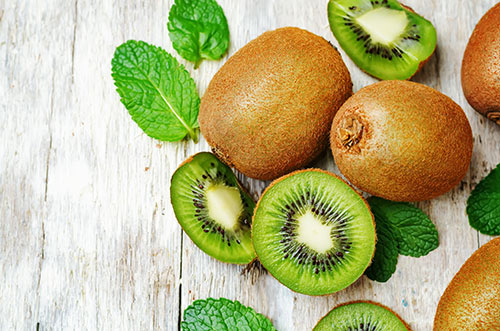Oggi ti parlo del kiwi, un alimento ottimo da molti punti di vista.
Il Kiwi è un frutto esotico, originario della Cina, una bacca prodotta dalla Actinidia deliciosa; si è diffuso in Europa nel 900 ed l’Italia ne è diventata una grande produttrice, principalmente nelle regioni del Piemonte e del Lazio. Le sue varietà più diffuse sono il kiwi verde e il kiwi gold.
Per 100 gr di prodotto abbiamo circa:
| Valori nutrizionali | |
| Kcal | 44 |
| Acqua | 84% |
| Carboidrati | 9 gr |
| Proteine | 1,2 gr |
| Lipidi | 0,6 gr |
| Fibre :solubili |
2,2 gr 0,8 gr |
| Vitamine | |
| Vitamina C | 85 mg |
| Minerali | |
| Potassio | 400mg |
| Ferro | 0,5mg |
La presenza di fibre facilità la motilità intestinale; in alcuni soggetti può però avere effetti lassativi, dunque prima di assumerne in quantità eccessiva accertati di tollerarlo!Ha un ottimo contenuto di acqua, potassio ed antiossidanti e un discreto contenuto di Vitamina C.
Inoltre in un kiwi medio, intorno agli 80 gr, troviamo circa 33,6 mg di acido alfa-linolenico (omega3), un acido grasso polinsaturo che ha l’importante funzione di abbassare nel sangue i livelli di trigliceridi, i cui valori elevati aumentano il fattore di rischio cardiovascolare.
Ma oltre alle proprietà benefiche, vanno tenuti presenti altri aspetti, quali la già citata proprietà lassativa e in alcuni soggetti reazioni allergiche fino anche a shock anafilattico a causa di una proteina, l’enzima actinidina. Quindi durante l’allattamento è opportuno prestare attenzione all’assunzione di questo prodotto soprattutto se ci sono casi di allergie in famiglia.
Per tutti gli altri buon Kiwi! 😉
Today we talk about the kiwi, fruit that I love and I believe a great food many points of view. Let’s look at some aspects.
The Kiwi is an exotic fruit, native to China, a berry produced by Actinidia deliciosa; it has spread in Europe and 900, and Italy has become a major producer, primarily in the regions of Piedmont and Lazio. Its most common varieties are the kiwi green and gold kiwi .
Per 100 grams of product we have approximately :
| Nutritional Values | |
| Kcal | 44 |
| Water | 84% |
| Carbohydrates | 9 gr |
| Protein | 1,2 gr |
| Lipid | 0,6 gr |
| Fibers :soluble |
2,2 gr 0,8 gr |
| Vitamins | |
| Vitamin C | 85 mg |
| Minerals | |
| Potassium | 400mg |
| Iron | 0,5mg |
Thanks to the content of water , potassium and antioxidants, is well suited to ‘ supply of sports but also those suffering from hypertension.
Discreet content of vitamin C per 100 grams of kiwi , as indicated in the table , we are at 85 mg .
The presence of fibers ease intestinal motility ; in some subjects , however, can have a laxative effect , so before assuming excessively sure to tolleralo is crucial.
Furthermore, in a medium kiwi , about 80 grams , we find about 33.6 mg of alpha-linolenic acid ( omega-3 ) , a polyunsaturated fatty acid which has the important function to lower blood triglyceride levels , whose high values increase the cardiovascular risk factor .
But in addition to the beneficial properties, must be taken of other aspects , such as the aforementioned laxative property and allergic reactions in some subjects even up to anaphylactic shock due to a protein , the enzyme actinidina . So while breast-feeding should be careful taking this product if there are cases of allergies in the family.
For all other, good Kiwi! 😉
